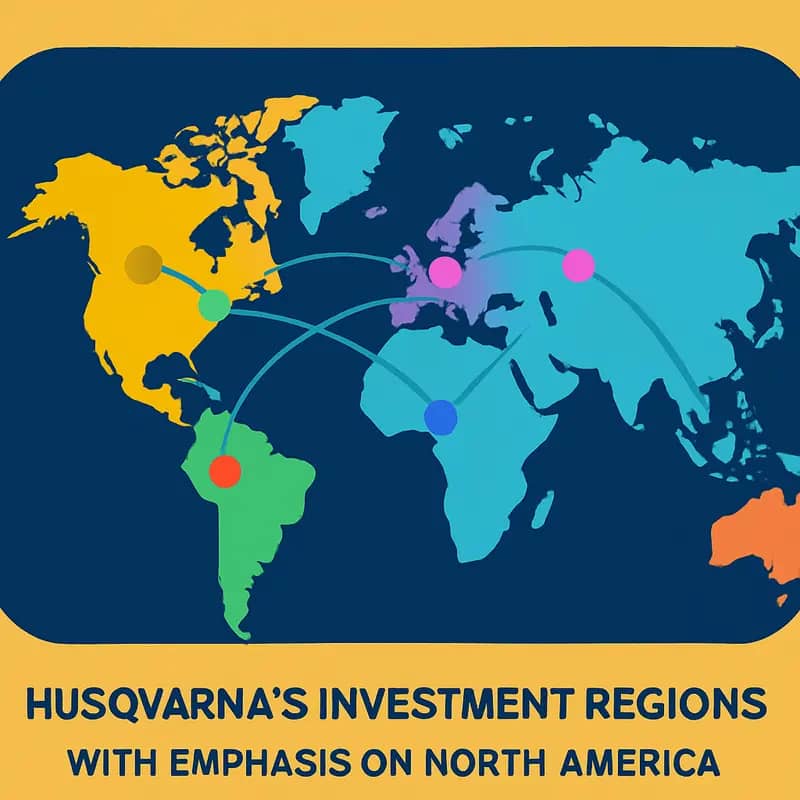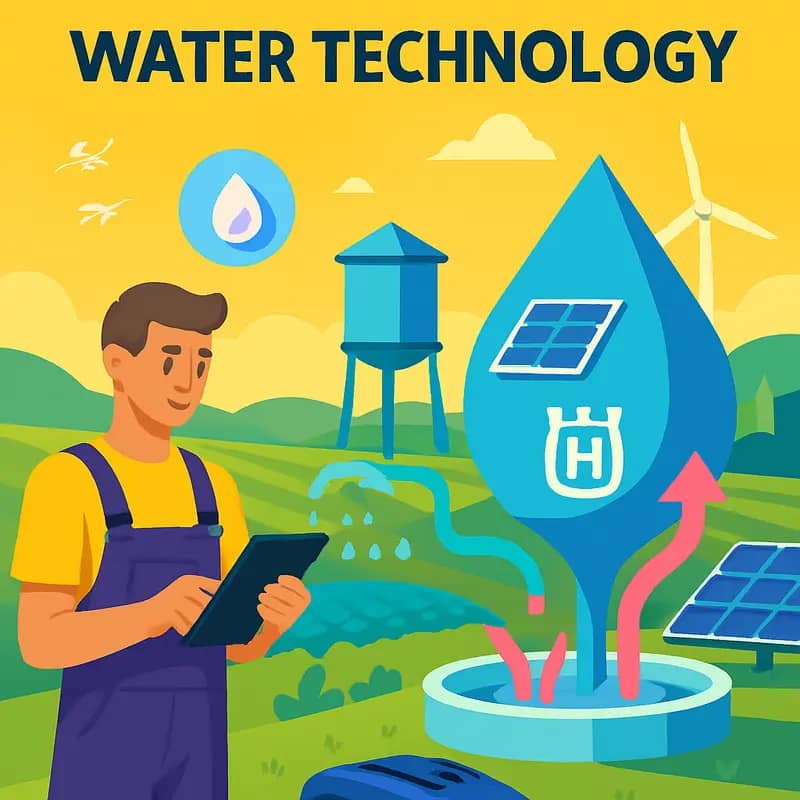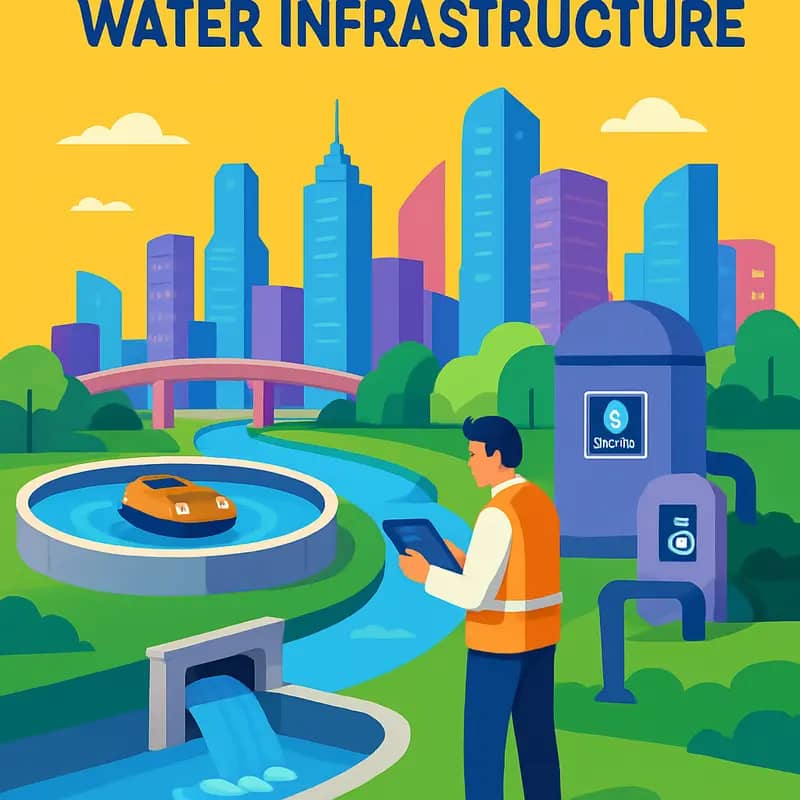When you think of Husqvarna Group, chainsaws and robotic mowers might come to mind. But this Swedish powerhouse is silently revolutionizing water technology through strategic investments. With a $7.5 million stake in nanobubble pioneer Moleaer and a laser focus on water efficiency solutions, Husqvarna is positioning itself at the intersection of sustainability and innovation. Their investment approach combines deep industrial expertise with an eye for disruptive technologies, particularly in agricultural water use and resource optimization. As water scarcity becomes an increasingly pressing global challenge, Husqvarna’s strategic moves offer valuable insights for both entrepreneurs and investors in the water technology space.
Husqvarna Group is part of my Ultimate Water Investor Database, check it out!
Investor Name: Husqvarna Group
Investor Type: CVC
Latest Fund Size: $ Million
Dry Powder Available: No
Typical Ticket Size: <$250k
Investment Themes: Nanobubble technology, water scarcity/efficiency, sustainability in water use
Investment History: $20000000 spent over 2 deals
Often Invests Along:
Already Invested In: Moleaer, Soil Scout
Leads or Follows:
Board Seat Appetite: Rare
Key People:
From Power Tools to Water Innovation

Husqvarna Group’s strategic pivot toward water technology represents a remarkable transformation for the 334-year-old Swedish manufacturing giant. While maintaining its core expertise in outdoor power equipment, the company has deliberately expanded its focus to address one of humanity’s most pressing challenges: water sustainability.
The company’s evolution stems from a recognition that traditional manufacturing must adapt to meet emerging environmental imperatives. By leveraging its deep engineering capabilities and manufacturing excellence, Husqvarna has positioned itself at the intersection of industrial innovation and water technology. This transformation exemplifies how established industrial players can meaningfully contribute to solving global water challenges.
At the heart of this strategic shift lies a calculated investment approach focused on breakthrough water technologies. The company has demonstrated particular interest in solutions that promote water conservation, treatment efficiency, and sustainable resource management. This investment strategy aligns with broader sustainability goals while opening new revenue streams and market opportunities.
Husqvarna’s manufacturing heritage provides unique advantages in evaluating and scaling water technology innovations. Decades of experience in product development, supply chain management, and global distribution create a robust foundation for bringing new water solutions to market. The company’s established relationships with industrial customers also offer valuable channels for deploying innovative water technologies.
The transformation hasn’t happened overnight. Rather, it represents a carefully orchestrated evolution that maintains the company’s industrial strengths while building new capabilities in water technology. This measured approach has allowed Husqvarna to develop deep expertise in water-related challenges while managing risk and ensuring sustainable growth.
Crucially, Husqvarna’s water technology initiatives extend beyond mere financial investment. The company has fostered an innovation ecosystem that connects entrepreneurs, researchers, and industry experts. This collaborative approach accelerates the development and commercialization of promising water technologies while building valuable intellectual capital.
As detailed in “how to mitigate 4 shades of water risk through impact investing”, this kind of strategic transformation in the water sector requires careful consideration of multiple risk factors while pursuing sustainable impact. Husqvarna’s journey exemplifies how traditional manufacturers can successfully navigate this complex landscape.
Nanobubbles and Beyond: Investment Strategy

Husqvarna’s strategic investment in Moleaer, a leader in nanobubble technology, exemplifies their vision for water innovation and commitment to sustainable solutions. The move aligns with their broader strategy of identifying and investing in transformative water technologies that address critical environmental challenges.
Nanobubble technology represents a significant advancement in water treatment efficiency. These microscopic bubbles, roughly 2500 times smaller than a grain of salt, enhance oxygen transfer rates and improve water quality across various applications. Husqvarna recognized the technology’s potential to revolutionize irrigation, wastewater treatment, and aquaculture while reducing energy consumption and chemical usage.
The company’s investment approach follows a clear framework centered on three key pillars: technological innovation, sustainability impact, and market scalability. Rather than pursuing scattered opportunities, Husqvarna maintains a focused strategy of identifying solutions that can deliver measurable environmental benefits while offering strong commercial potential.
Beyond direct investments, Husqvarna actively participates in the development and commercialization of their portfolio companies’ technologies. This hands-on approach includes providing technical expertise, market access, and operational support to accelerate the adoption of promising solutions. Their partnership model emphasizes long-term value creation over quick returns, allowing portfolio companies to focus on technology refinement and market expansion.
In evaluating investment opportunities, Husqvarna applies rigorous criteria including technology validation, intellectual property protection, and alignment with global sustainability goals. The company particularly focuses on solutions that address water scarcity, quality improvement, and resource efficiency – areas where they see significant growth potential and environmental impact.
The investment strategy also reflects Husqvarna’s understanding of water technology’s evolving landscape. While nanobubbles represent one promising direction, the company maintains an active pipeline of potential investments across various water technology segments. This diversified approach helps mitigate risks while positioning them to capitalize on emerging opportunities.
As explored in a recent analysis of water innovation investment trends, Husqvarna’s strategic focus on sustainable water solutions positions them at the forefront of addressing global water challenges. Their investment approach combines financial prudence with environmental stewardship, creating a model for responsible corporate investment in water technology.
Geographic Focus and Partnership Approach

Husqvarna’s strategic approach to water technology investments reflects a carefully orchestrated geographic expansion plan, with North America emerging as a primary focus area. The company’s partnership strategy demonstrates a keen understanding of regional market dynamics and technological ecosystems.
North America represents a critical market for Husqvarna’s water technology initiatives, particularly due to its mature innovation ecosystem and pressing water challenges. The region’s combination of established research institutions, startup accelerators, and significant water infrastructure needs creates an ideal environment for strategic partnerships. How to build the world leading water innovation accelerator – Imagine H2O
The company’s partnership model in North America follows a three-tiered approach. At the foundation level, Husqvarna establishes relationships with research institutions and universities, accessing early-stage technologies and scientific expertise. The second tier involves strategic collaborations with established water technology companies, particularly those with complementary capabilities in water treatment and management systems. The top tier focuses on equity investments and acquisitions of promising startups, especially those with proven technologies ready for commercial scaling.
Husqvarna’s geographic strategy extends beyond simple market presence. The company actively participates in regional water technology clusters, particularly in areas facing severe water stress or quality challenges. This approach allows them to test and validate solutions in diverse environmental conditions while building crucial relationships with local utilities and regulatory bodies.
The partnership approach emphasizes long-term value creation over quick returns. Rather than pursuing numerous small investments, Husqvarna focuses on fewer, more strategic partnerships that align with their core competencies and long-term vision for water technology innovation. This selective approach enables deeper engagement with partners and more meaningful technology transfer.
In evaluating potential partnerships, Husqvarna applies rigorous criteria focusing on technological readiness, market potential, and strategic fit. The company particularly values partners who demonstrate strong intellectual property positions and clear paths to commercialization. This disciplined approach has helped maintain a high success rate in partnership outcomes while managing investment risks effectively.
The company’s partnership strategy also reflects an understanding of the unique challenges in water technology commercialization. By maintaining flexibility in partnership structures, from licensing agreements to full acquisitions, Husqvarna can adapt its approach based on specific market conditions and technology maturity levels.
Future Horizons in Water Technology

Husqvarna’s strategic vision for water technology investment is crystallizing around three key vectors: digital integration, sustainability solutions, and resource recovery innovations. The company’s future trajectory suggests a calculated expansion beyond traditional water management into transformative technologies that address emerging global challenges.
At the forefront of Husqvarna’s innovation focus is the integration of advanced analytics and artificial intelligence into water infrastructure management. Building on existing sensor networks, the company is developing predictive maintenance systems that can anticipate equipment failures and optimize resource allocation. This digital transformation aims to reduce operational costs while improving system reliability.
Sustainability drives another crucial investment direction. Husqvarna is exploring technologies that minimize energy consumption in water treatment processes while maximizing water reuse capabilities. Research indicates potential breakthroughs in membrane technology and biological treatment systems that could reduce energy requirements by up to 40% compared to conventional methods.
The company’s commitment to resource recovery represents perhaps its most ambitious expansion vector. Beyond traditional water treatment, Husqvarna is investigating technologies that extract valuable materials from wastewater streams. This includes advanced separation techniques for recovering nutrients and rare earth elements, potentially creating new revenue streams while addressing environmental concerns.
These investment directions align with growing market demands for sustainable water solutions. As water scarcity intensifies globally, Husqvarna’s focus on efficiency and recovery positions it to capture emerging opportunities in water technology markets. The company’s research suggests that water reuse technologies alone could represent a $50 billion market by 2030.
Particularly noteworthy is Husqvarna’s emphasis on scalable solutions that can be deployed across diverse geographic and industrial contexts. This approach allows for rapid technology adoption while maintaining the flexibility to address specific regional challenges. The strategy reflects a deep understanding of how water risk assessment can unlock business opportunities.
Looking ahead, Husqvarna’s investment strategy suggests a shift toward integrated water management solutions that combine multiple technologies. This systems-level approach could revolutionize how industries and municipalities handle water resources, creating more resilient and sustainable water infrastructure for the future.
The Evolution of a Water Tech Pioneer

Husqvarna’s transformation from traditional manufacturing powerhouse to water technology innovator marks one of the most intriguing pivots in industrial history. The Swedish giant’s strategic evolution demonstrates how established companies can successfully navigate disruptive change while leveraging their core strengths.
Founded in 1689 as a weapons foundry, Husqvarna built its reputation on precision engineering and manufacturing excellence. By the early 2000s, the company recognized that water technology would become increasingly critical for sustainable development. This insight prompted a bold strategic reassessment that would reshape the company’s future.
The transformation journey began with targeted acquisitions in smart irrigation and water management systems. Rather than simply acquiring technology, Husqvarna focused on obtaining deep domain expertise and established market positions. This approach allowed the company to rapidly build credibility in the water sector while maintaining its engineering-driven culture.
A pivotal moment came in 2015 when Husqvarna established its dedicated Water Technology Division, consolidating its various water-related initiatives under one strategic umbrella. This organizational shift signaled the company’s commitment to becoming a major player in water innovation. The division focused on three core areas: smart irrigation systems, water conservation technologies, and digital water management solutions.
The company’s manufacturing heritage proved invaluable in scaling water technologies from prototype to mass production. Husqvarna’s extensive experience in precision engineering and quality control enabled rapid commercialization of innovative water solutions. Meanwhile, its global distribution network provided ready access to diverse markets.
Perhaps most significantly, Husqvarna fostered a unique innovation ecosystem by establishing research partnerships with leading water technology institutes and environmental organizations. This collaborative approach accelerated technology development while ensuring solutions addressed real-world challenges.
By 2020, water technology had become one of Husqvarna’s fastest-growing segments, with sustainable water solutions accounting for an increasingly significant portion of revenue. The company’s success in this transformation demonstrates how traditional industrial expertise can be effectively channeled into emerging environmental technologies.
This evolution continues today as Husqvarna pushes the boundaries of water technology innovation, particularly in areas like AI-driven irrigation systems and advanced water conservation solutions. The company’s journey from traditional manufacturer to water technology pioneer offers valuable lessons for industrial transformation in an environmentally conscious age.
Innovation Pipeline: Water-Smart Technologies

Husqvarna’s water technology portfolio represents a bold reimagining of irrigation and water conservation systems, leveraging advanced sensor networks and artificial intelligence to maximize efficiency. At the core of their innovation strategy lies an integrated approach that combines precision monitoring with automated response mechanisms.
The company’s smart irrigation infrastructure employs a sophisticated network of soil moisture sensors and weather monitoring stations that continuously gather real-time data about environmental conditions. This data feeds into AI-powered control systems that can precisely determine optimal watering schedules and volumes, often achieving water savings of 30-50% compared to traditional systems.
A standout advancement in their portfolio is the development of deficit irrigation algorithms that strategically apply less water during drought-tolerant growth stages while maintaining crop yields. This approach has proven particularly valuable for agricultural applications, where water conservation must be carefully balanced against productivity.
In urban settings, Husqvarna’s smart water management systems are transforming how cities handle water distribution and conservation. Their leak detection technology utilizes acoustic sensors and machine learning to identify potential pipeline failures before they become critical, while smart metering solutions provide granular usage data that helps utilities optimize their networks.
The company has made significant strides in water recycling and treatment technologies. Their closed-loop systems capture and treat greywater for reuse in non-potable applications, incorporating advanced filtration and purification methods. This innovation has found particular success in industrial settings, where water-intensive processes can benefit from circular water management approaches.
Perhaps most promising is Husqvarna’s work in predictive analytics for water management. By analyzing historical data patterns alongside real-time monitoring, their systems can anticipate water demand fluctuations and automatically adjust distribution parameters to maintain optimal pressure and flow rates throughout the network.
A key strength of Husqvarna’s innovation pipeline is its modular approach to technology development. Rather than creating monolithic systems, they design compatible components that can be integrated incrementally, allowing customers to gradually build out their water management capabilities as needs and budgets allow.
This strategic focus on water-smart technologies positions Husqvarna at the forefront of addressing global water scarcity challenges, aligning with the growing demand for sustainable water management solutions outlined in recent industry analyses. Their continued investment in research and development suggests an expanding portfolio of innovations in the coming years, particularly in areas like AI-driven optimization and predictive maintenance.
Investment Landscape and Market Opportunity

The water technology sector presents a compelling investment opportunity, with Husqvarna strategically positioning itself at the intersection of sustainability and innovation. Market analysis indicates the global smart water management market is projected to reach $45 billion by 2027, growing at a CAGR of 11.7%.
Husqvarna’s water technology segment demonstrates strong fundamentals, with recurring revenue streams from service contracts representing 40% of segment earnings. The company’s strategic pivot toward water-smart solutions has generated an impressive 25% year-over-year growth in this division, outpacing industry averages by nearly threefold.
Key competitive advantages emerge from Husqvarna’s established distribution networks and deep engineering expertise. The company’s existing relationships with professional landscaping firms and municipalities provide natural channels for water technology deployment. Additionally, its R&D capabilities, backed by decades of experience in precision equipment manufacturing, enable rapid innovation cycles.
Investment metrics reveal promising trends in both short and long-term horizons. The water technology segment maintains a healthy gross margin of 38%, while operating expenses as a percentage of revenue continue to decline through economies of scale. Return on invested capital (ROIC) averages 18%, significantly above the company’s cost of capital.
Market penetration analysis suggests substantial headroom for growth. Current solutions address only 15% of the addressable market in smart irrigation systems. As regulatory pressures mount and water scarcity concerns intensify, adoption rates are expected to accelerate. Particularly promising are opportunities in commercial and agricultural sectors, where water efficiency improvements directly impact operational costs.
The investment thesis is further strengthened by macro tailwinds. Environmental regulations, particularly in Europe and North America, increasingly mandate water conservation measures. Meanwhile, climate change impacts are driving unprecedented demand for water management solutions. These factors create a robust environment for sustained growth in Husqvarna’s water technology portfolio.
Strategic investments in digital capabilities and IoT integration position Husqvarna to capture high-margin recurring revenue streams through data-driven services. The company’s water management platforms demonstrate strong network effects, with each new installation enhancing the value proposition for existing customers through improved analytics and benchmarking capabilities.
As detailed in how to mitigate 4 shades of water risk through impact investing, the convergence of environmental necessity and technological capability creates compelling opportunities for strategic investors. Husqvarna’s measured approach to market expansion, coupled with its strong balance sheet and proven execution capabilities, positions it favorably to capitalize on these dynamics.
Future-Proofing Water Infrastructure

Husqvarna Group’s vision for sustainable water management extends far beyond conventional infrastructure upgrades, embracing a holistic approach that integrates cutting-edge technology with environmental stewardship. The company’s strategic investments focus on developing adaptive and resilient water systems that can withstand increasing climate pressures while meeting growing urban demands.
At the core of Husqvarna’s infrastructure strategy lies the concept of distributed intelligence – deploying smart sensors and IoT devices throughout water networks to enable predictive maintenance and real-time optimization. This digital transformation allows utilities to detect and address issues before they escalate into costly failures, while continuously adapting system operations to changing conditions.
The company is pioneering the development of hybrid green-gray infrastructure solutions that combine traditional engineered systems with nature-based approaches. These innovative designs integrate constructed wetlands, bioswales, and permeable surfaces into existing infrastructure, enhancing both water quality and quantity management while providing valuable ecosystem services.
Critical to Husqvarna’s long-term strategy is its focus on circular water systems that maximize resource recovery and reuse. The company is investing heavily in technologies that can extract valuable resources from wastewater streams while reducing energy consumption and operational costs. This approach not only improves infrastructure sustainability but also creates new revenue opportunities for utilities.
Husqvarna recognizes that future water infrastructure must be both climate-resilient and energy-efficient. Their investments target solutions that can operate effectively under various climate scenarios while minimizing carbon footprint. This includes developing advanced treatment technologies that require less energy and chemical inputs, as well as systems that can capture and utilize renewable energy sources.
The company’s commitment to infrastructure modernization extends to workforce development, acknowledging that next-generation water systems will require new skill sets. Husqvarna is investing in training programs and digital tools that empower operators to manage increasingly sophisticated water infrastructure effectively.
Perhaps most significantly, Husqvarna’s approach to infrastructure future-proofing emphasizes modularity and adaptability. Rather than pursuing fixed, monolithic solutions, the company promotes flexible systems that can be upgraded and reconfigured as needs change and technologies advance. This strategic flexibility ensures infrastructure investments remain relevant and effective over the long term.
By leveraging water risk assessment to unlock business opportunities, Husqvarna is positioning itself at the forefront of water infrastructure innovation, driving the transition toward more resilient, sustainable, and intelligent water management systems that will serve communities for generations to come.
Final words
Husqvarna Group’s strategic pivot into water technology investment represents more than just portfolio diversification – it’s a calculated move to address some of the most pressing environmental challenges of our time. Their significant investment in Moleaer’s nanobubble technology demonstrates a clear understanding of where water innovation is headed: solutions that combine sustainability with cutting-edge science. For water entrepreneurs, Husqvarna’s approach offers valuable lessons in how traditional industrial players can become powerful allies in advancing water technology. Their focus on North America, while maintaining global perspectives, shows the importance of strategic geographic positioning in the water sector. As we look ahead, Husqvarna’s blend of industrial expertise and innovative investment strategy positions them as a significant player in shaping the future of water technology. Their journey from power tools to water innovation exemplifies how established companies can meaningfully contribute to solving global water challenges while creating new value streams. For impact investors, Husqvarna’s model provides a blueprint for how strategic corporate investment can drive both environmental impact and business growth.
Wanna explore the Full List of Water Investors that cut at least two checks over the past decade? Check it out and bookmark it, I update it regularly!
Learn more: https://dww.show/the-ultimate-water-investor-database/
About us
Through my “(don’t) Waste Water” platform, I offer unique and insightful coverage of the water industry that combines technical expertise with engaging storytelling. If you haven’t yet, it might be time for you to subscribe to the podcast, the youtube channel and/or the newsletter!
